前面3篇关于去耦电容的文章引起了很多硬件工程师的兴趣,这期的直播课程中讲述了“电源、地、去耦电容”,感觉很多网友对于在PCB设计中如何处理“地”一样是一头雾水,网上太多的经验贴其实都让人消化不良,我觉得有必要对PCB上对“地”的处理再补充说明一下。
用KiCad软件对“地”的处理
正好看到Allaboutcircuits网站上的一篇比较通俗易懂的相关文章,在这里借花献佛分享给大家。我一向主张硬件工程师应该尽快掌握专业英语的阅读,因此这篇文章我就原文贴在这里,我个人以要点汇总的方式做一下点评。
以下是作者的原文,蓝色的部分为我的摘要
PCB Layout Tips and Tricks: Use a Ground Plane Whenever Possible
July 11, 2018byRobert Keim
I don’t deny that it is possible to design a PCB without a ground plane, and in many cases you can create a fully functional board this way (or at least it will be fully functional when operating in a favorable environment). But ground planes are an easy way to improve performance and prevent problems, and in my opinion there are few situations in which it is a good idea to make ground connections using ordinary traces.
--作者认为PCB设计是可以没有“地平面”的,尤其是在一些比较宽松的环境下没有地平面,板子也能够很好地工作,但如果要提升性能、防止出现问题,地平面是比较简单的方式,在作者看来,只有很少的情况才会只是用普通的走线(Trace和Track都是板子上走线的意思)来进行“地”的连接。
Copper Is a Resistor
Schematic diagrams have wires, but in real life there are no wires (unless someone has started manufacturing PCBs using superconductors...). Physical interconnects, including PCB traces, are low-value resistors. The fact that we can often ignore this interconnect resistance doesn’t mean that it has no effect on the functionality of a circuit. On page 8 ofthis documentpublished by Analog Devices, the author demonstrates that a 5 cm PCB trace can introduce over 1 LSb of error in the digitized values generated by a 16-bit ADC.
-- 我们原理图上的连线都是理想的信号连接(只是“线”),在实际的生活中是不存在的,任何物理连接,包括PCB上的走线,都是有比较低的阻抗的,在多数情况下我们可以忽略低阻抗产生的效应,但是在有些场合它们可能会对电路的功能产生显著的影响。ADI公司曾证明了5cm长的PCB走线可能会导致16位ADC的量化结果中引入超过1LSb的误差。

PCB上走线导致的电阻
In many cases there is not much we can do to mitigate the effects of resistance in a signal trace: tiny ICs and the desire for circuit miniaturization often lead to crowded layouts that don’t allow for wide traces or optimal component placement. We can, however, improve the overall situation by using a ground plane, which reduces the resistance of the return path.
-- 很多情况下我们无法减少这些走线电阻带来的影响,现在的板子越来越小型化,器件也越来越小,所以拥挤的板子上不允许较宽的走线以及非常充裕的空间让你摆放器件到最佳的位置,在这种情况下,“接地平面”就可以通过为信号回路提供非常低的阻抗来改善整体的性能。
This decreased return-path resistance is a fundamental benefit of incorporating a ground plane into your PCB. It reduces noise caused by variations in return current, and it establishes a more uniform ground voltage (because less resistance means less voltage being dropped between physically separated portions of the ground net). By dedicating an entire layer to ground and connecting everything to the plane using vias and through-holes, you are making your physical circuit more like the idealized circuit in the schematic diagram.
-- 在PCB设计中采用接地平面最大的好处就是能够降低回路阻抗,它降低了返回电流变化引起的噪声,在整个板子上也会有更均匀的接地电压(低阻抗意味着较低的压降),如果整个层用做“接地平面”,通过过孔(via)或通孔将相关的电源等连接到接地平面上,物理的电路工作起来就非常接近原理图了。
Simpler and Smaller
A ground plane improves the electrical characteristics of your circuit while also simplifying your layout task and in some cases reducing the size of your PCB. I’m not going to dwell on these aspects because I think that they’re more or less self-explanatory. The plane allows you to access the ground net anywhere you can squeeze in a via—and squeezing in a via is far easier than snaking a ground connection through a tangled assortment of traces, copper pours, and fine-pitch ICs.
-- 接地平面可以改善电路的性能,PCB布局布线工作也变得简单,并且有可能缩小PCB的尺寸,这些都是不言而喻的,在PCB上任何可以打一个过孔的地方都可以就地接入地平面,这要比你通过各种方式走线来实现到地的连接简单多了。
This improved routing may allow you to push the components closer together and thus decrease board size, though there is also the possibility that the board will end up larger if the ground plane causes you to lose one of two component layers (I’ll revisit this issue toward the end of the article).
-- 布线方便、元器件可以靠得更紧凑、板子也可以做得更小。当然如果你专门留出一个层做为“地平面”,你会少一个能走线的层,也许会让你的板子变得更大。
Avoid Ground Loops
In my experience, the term “ground loop” can refer to any situation in which a system is affected by a difference in ground potential. A typical example is when two modules are connected by a long cable and the return current in the cable causes one module’s ground voltage to be significantly higher than the other module’s ground voltage. In this discussion, though, I’m referring specifically to a loop of ground connections; for example:
-- 术语“地面回路”可以指系统受“地电位差”影响的任何情况。 一个典型的例子是当两个模块通过长电缆连接时,电缆中的返回电流导致一个模块的接地电压明显地高于另一个模块的接地电压。 在这里,作者指的是一个接地环路, 例如下图:
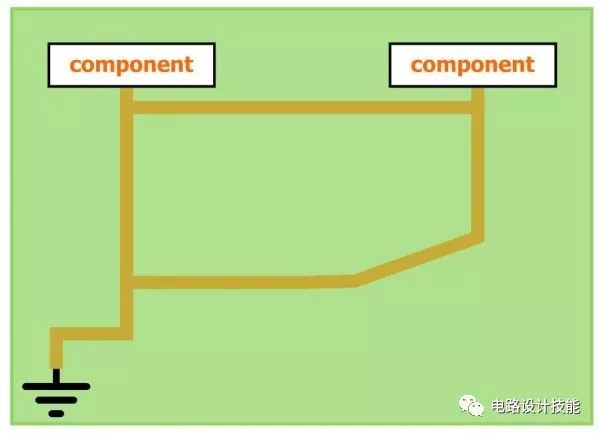
If you have to make numerous ground connections using individual PCB traces, it would not be difficult to create a loop like the one shown above. If you’ve readmy article on mutual inductance, you know that this sort of conductive loop is a good receiver of magnetic interference.
--如果必须使用单独的PCB走线进行多个地方的接地连接,会很容易出现上面的环路,这种导电环路非常容易接收磁干扰(像天线一样,有时候示波器探头的接地线也会形成受干扰的环路)。
The presence of a ground plane does not make it impossible to create a ground loop, since the CAD program won’t prevent you from drawing traces between ground points. But if you consistently make your ground connections using vias or through-holes, the problem should largely disappear: by dropping vias to the plane you are making a direct connection from the component to a ground point that is connected through low impedance to all other ground points in the circuit.
-- 使用了地平面并不意味着你不会产生这种接地回路,PCB的设计工具无法阻止你在各个接地点之间进行连线。如果你习惯了使用过孔或通孔进行接地连接,上面的问题就很容易避免:通过过孔直接连接“地平面”,元器件到任何一点“地”之间的连接阻抗都非常低。
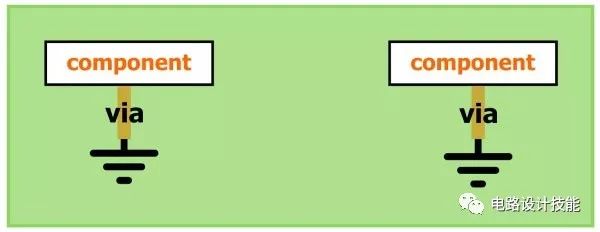
An Integrated Shield
A solid ground plane provides some degree of protection againstelectromagnetic interference(both radiated and received). I wouldn’t rely on a ground plane to solve all of your EMI problems, especially if you have components on both sides of the board; a carefully designed conductive enclosure would be more effective. Nonetheless, every little bit helps, and if you’re concerned about EMI then you have one more reason to incorporate a ground plane into your layout.
-- 接地平面还能够防止电磁干扰(辐射和接收)。当然不要指望接地平面来解决所有的EMI问题,尤其是电路板的两侧都有元件的时候,用导电外壳会更有效。尽管如此,接地平面的使用对于EMI的改善还是有一定帮助的。
The PCB-Plane Capacitor
This is not a major benefit, and it applies only to ground planes that are adjacent to a power plane. I think it’s still worth mentioning, though. A ground plane separated from a power plane by a thin dielectric sounds a lot like a parallel-plate capacitor, and that’s exactly what it is. This structure adds a bit of distributed power-supply capacitance to your entire circuit board, though it certainly isn’t going to replace yourdecoupling capacitors.
-- 与电源平面相邻的地平面会形成“板间电容”,为整个电路板增加了一些分布式电源电容,起到一定的去耦作用,虽然无法完全取代你电路中的去耦电容。
Practical Impediments
I cannot imagine a scenario in which a four-layer PCB would not have a ground plane. I suppose it’s possible that a very dense layout would need both internal layers for normal signal routing, but honestly that seems unlikely: there’s no doubt that the plane occupies routing area, but by simplifying ground connections it also reduces the amount of routing area that the board will require.
-- 四层PCB板一般都要有地平面,当然有两个平面(电源平面和地平面)会更好,多用“平面”会减少信号走线层,但因为有了“平面”会简化布线的难度。用多少个平面要根据实际的情况综合考虑作出平衡。
A much more realistic scenario is that a ground plane is omitted because schedule or budgetary concerns argue in favor of a two-layer board. Now the ground plane is consuming one of only two PCB layers. Is it really better to include a ground plane if that means cramming almost all of the traces and components onto one layer? In my opinion, yes, it’s still better to include a ground plane, unless the circuit is so straightforward that you can use well-organized, low-impedance traces to make your ground connections. But honestly, if your space constraints are so extreme that you can’t make the board large enough to accommodate a ground layer on the bottom and a clean layout on the top, you should move to a four-layer board.
-- 两层板的设计中是否应该拿出一层来做地平面呢?这将意味着几乎所有的走线和器件都要在一层上搞定,作者认为,这是值得的,有地平面会更好,可以使用组织良好的低阻抗走线来建立接地连接。如果板子的空间限制非常严重,以至于无法使电路板足够大以容纳底部的接地层和顶部的干净布局走线,就应该考虑用4层板。
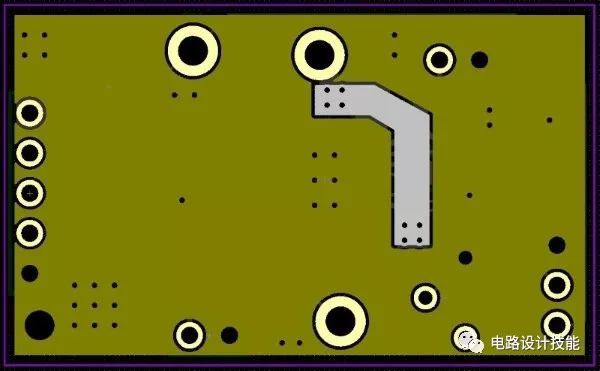
这是作者曾经设计的2层电路板的接地层,接地平面不必100%都是“地”,必要的时候也可以拿出一部分用于必须的走线。
Summary
Adding a ground plane to your PCB is a simple, low-cost, highly effective way to design electronic devices that have better signal integrity, higher accuracy, and more resistance to interference. If you’re not in the habit of incorporating a ground plane, make sure to keep these benefits in mind when it comes time to lay out your next board.
-- 在PCB上添加接地平面是一种简单、低成本、高效的方法来设计具有更好信号完整性、更高精度和更强抗干扰性的电子产品。因此在设计PCB的时候应尽可能养成使用接地平面的习惯。
-
电路
+关注
关注
173文章
5985浏览量
173414 -
pcb
+关注
关注
4333文章
23217浏览量
401724
原文标题:PCB设计中为什么尽量用地平面?
文章出处:【微信号:xiaojiaoyafpga,微信公众号:电子森林】欢迎添加关注!文章转载请注明出处。
发布评论请先 登录
相关推荐
电源/地平面对的模型
接地平面(转载)(不针对PCB板天线)
混合信号PCB设计中地平面铺设方式和单点接地
【高速PCB布线指南3】接地平面漫谈
内层的电源平面、地平面如何设计?
PCB软件性能怎样影响电源平面和地平面的布局?
电源地平面的分割技巧





 PCB设计是可以没有“地平面”的
PCB设计是可以没有“地平面”的
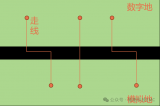
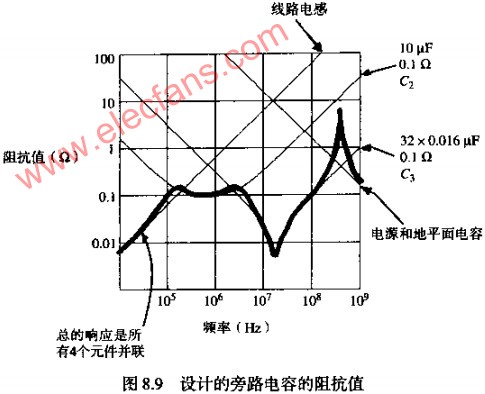

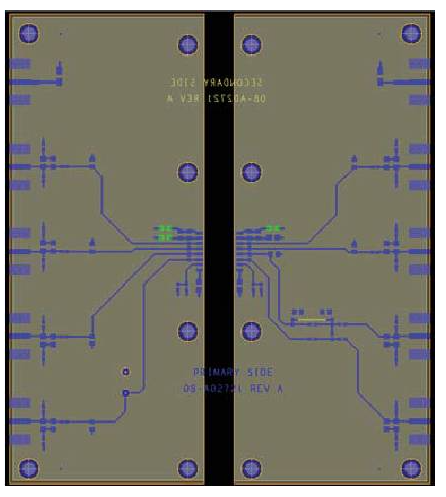
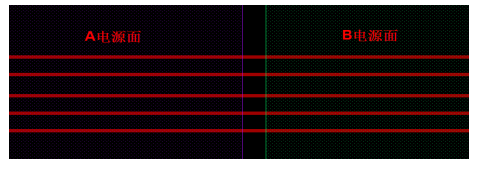











评论